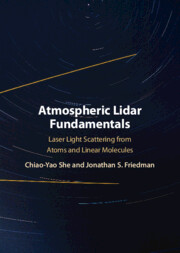Book contents
- Atmospheric Lidar Fundamentals
- Atmospheric Lidar Fundamentals
- Copyright page
- Dedication
- Contents
- Foreword
- Preface
- 1 Introduction
- 2 Classical Light Scattering Theory
- 3 Semiclassical Treatment of Light Absorption and Scattering from Atoms
- 4 Rayleigh and Raman Scattering from Linear Molecules
- 5 Introduction to Lidar Remote Sensing and the Lidar Equation
- 6 Common (Broadband) Lidar Types and Associated Applications
- 7 Lidars for Profiling Aerosol Optical Properties, Atmospheric Temperature and Wind
- 8 Transmitting and Receiving Optics
- Book part
- Index
- References
6 - Common (Broadband) Lidar Types and Associated Applications
Published online by Cambridge University Press: 24 February 2022
- Atmospheric Lidar Fundamentals
- Atmospheric Lidar Fundamentals
- Copyright page
- Dedication
- Contents
- Foreword
- Preface
- 1 Introduction
- 2 Classical Light Scattering Theory
- 3 Semiclassical Treatment of Light Absorption and Scattering from Atoms
- 4 Rayleigh and Raman Scattering from Linear Molecules
- 5 Introduction to Lidar Remote Sensing and the Lidar Equation
- 6 Common (Broadband) Lidar Types and Associated Applications
- 7 Lidars for Profiling Aerosol Optical Properties, Atmospheric Temperature and Wind
- 8 Transmitting and Receiving Optics
- Book part
- Index
- References
Summary
In Chapter 6, we concentrate on the broadband lidars, from the point of view of the lidar equation as described in Chapter 5. Here, we describe in detail Rayleigh–Mie (elastic backscattering) lidars in regions with and without the presence of aerosols. Next, we move to polarization lidars for the study of aerosols and cloud particles. Here, we use Stokes vectors to describe the transmitting beam and Mueller matrices for optical elements and the individual scatterers in the atmosphere. We move from polarization lidar to Raman and DIAL lidar for monitoring minor species, carrying out a detailed comparison of the two techniques, including analysis of their relative uncertainties. We close with a brief overview of lidars not presented in this book, but which are nevertheless important and worth mentioning. These include airborne and spaceborne systems, particulate and air pollution monitoring systems, and those used for 3–D mapping and profiling, archeology, and other hard–target applications.
Keywords
Information
- Type
- Chapter
- Information
- Atmospheric Lidar FundamentalsLaser Light Scattering from Atoms and Linear Molecules, pp. 103 - 137Publisher: Cambridge University PressPrint publication year: 2022
